As Washington passively watches China pursue political and military domination in Asia, Africa, the Middle East, and now, apparently in Latin America, it’s clear to me that our leaders and Americans, in general, have short memories about how brutal the ruling Chinese Communist Party (CCP) can be.
That’s one reason why every year, on the anniversary of the June 4, 1989, Tiananmen Square massacre in Beijing, I post my personal recollections of that horrendous night.
What happened that night in the square and other Beijing neighborhoods should never be allowed to disappear from history. The events of that night need to be told and retold so the world will be reminded just how ruthless and pitiless China’s ruling communist autocrats are.
Unfortunately, many in Washington prefer to sweep that event into the ash heap of history. When it comes to China, massacres are inconvenient truths that need not be told.
After all, there is money to be made in China. So don’t remind us of what happened that night 35 years ago. Let sleeping dogs lie, and let’s continue kissing Xi Jinping’s derriere as he pursues his plan of world political and economic dominance.
However, I choose to remember that night in Beijing when the Chinese government sent its army into Tiananmen Square to slaughter thousands of students, workers, and political opponents of the ruling Communist oligarchy.
What happened that night 39 years ago remains incomprehensible to me. Tanks and armored personnel carriers roared into the square, mowing down pro-democracy demonstrators. Battle-hardened troops brought in from the tense border with Vietnam opened fire on unarmed students in what can only be called a massacre.
Today, some American politicians, including President Biden, say China is our friend—an affable but tough competitor in the global marketplace. I believe Biden is obliged (for multiple reasons) to cover up China’s deceitful behavior. But that’s a topic for another day.
The fact is, China is NOT our friend!
Any government that can murder its own children so indiscriminately and ruthlessly as it did 35 years ago cannot be trusted to act rationally or benevolently toward us or any other nation. We saw that behavior play out with the COVID-19 virus when the CCP purposely misled the world beginning in November 2019 about the severity of the deadly virus attacking Wuhan.
Why? The CCP reasoned that it should not suffer the scourge of the COVID-19 virus alone. If China’s economy were to crash, then the rest of the world would crash, too. That is exactly what happened.
The China of 2024 remains a nation of iron-handed one-party rule replete with human rights violations and corruption. This is a nation fixed on global economic and political domination. I do not doubt that if hundreds of thousands of students and protestors were to occupy Tiananmen Square again today, the result would be the same as it was on that summer night in 1989.
The post that follows contains my recollections of that gruesome night—one that is indelibly etched into my memory. It’s a little longer than most of my posts, but that bloody night in Tiananmen Square was also one of the longest I spent. I hope you will read on.
At the end of my post, you can click on the link to an interview I did with National Public Radio about the massacre a while back. Feel free to comment.
Tiananmen Square Diary
China became the world’s biggest story in the summer of 1989 when several hundred thousand students, labor leaders, and other dissidents occupied the five million-square-foot concrete piazza known as Tiananmen Square in the heart of Beijing. For seven weeks, as the world watched, some 500,000 “pro-democracy” demonstrators descended on Beijing’s most sacred site to protest corruption, human rights violations, and one-party rule.
The protest would ultimately end in the early morning hours of June 4 with the deaths of thousands of demonstrators in what the world has come to know as the “Tiananmen Square Massacre.” The Chinese Red Cross puts the number at 3,000, with 12,000 wounded. A recently declassified cable from then-British Ambassador Sir Alan Donald just 24 hours after the massacre said at least 10,000 people were killed in and around the square, and perhaps as many as 20,000 were wounded or injured.
 |
| Demonstrators in Tiananmen Before the Massacre |
Today, all evidence of that bloody night has been obliterated. Tiananmen Square is scrubbed and shimmering as it awaits the hundreds of thousands of summer visitors who will wander past the colossal portrait of Mao Zedong that hangs above the Forbidden City’s Gate of Heavenly Peace on the north end of the plaza and through the mausoleum that displays his waxy remains on the south end.
Despite the scourge of the COVID-19 virus, China today is relatively sanguine and confident. Profits, not protests, are the driving force among most Chinese. However, that was not the case in 1989 when Tiananmen Square was turned into a squalid, fetid tent city of protestors.
For many young Chinese, the tragedy that unfolded in Tiananmen Square 35 years ago is ancient history—an event that has been glossed over, covered up, and generally purged from the national consciousness by a nation eager to put forth its most dazzling and alluring face for tourists and the international business community.
But on June 3, 1989, as I walked through what is generally regarded as the planet’s largest city square, the world was just a few hours from seeing China at its most ruthless and ugliest.
That day, the square was a hot, grubby place strewn with refuse, canvas tents, and other makeshift dwellings. Under the towering “Heroes of the Nation,” obelisk demonstrators cooked rice and soup while others linked arms and sang a spirited rendition of the “Internationale,” the world socialist anthem. Thousands of others dozed under flimsy lean-tos or blasted music from boom boxes.
Near the middle of the square, the 30-foot tall “Goddess of Democracy,” a pasty white statue made of styrofoam and paper-mâché by art students, stared defiantly at Mao’s giant portrait—almost mocking the founder of modern-day China. A truck swept by, periodically spraying billowing clouds of insecticide and disinfectant over everything and everybody in its path.
 |
| Goddess of Democracy Statue |
Hawkers guided pushcarts containing ice cream, soft drinks, rice cakes, candy, and film encircled the students doing a brisk business. Even if the students in the square had not been able to topple China’s ruling hierarchy, at least there were profits to be made.
One enterprising entrepreneur raked in several hundred yuan within a few minutes after he began renting stepping stools for the hundreds of amateur photographers and tourists who arrived to have their pictures taken next to students or standing at the base of the “Goddess of Democracy” statue. I wrote that Tiananmen had evolved into a “Disneyland of Dissent.”
By June 3, the number of students occupying the square had dwindled to about 20,000 as thousands had packed up and headed back to their provinces. However, some students I talked with that afternoon were not ready to leave, and a few shared an intense sense of foreboding.
One of those was Chai Ling. Chai, elected “chief commander” by the dissidents, was the only woman among the seven student leaders of the pro-democracy protests. As we sat cross-legged on the hot pavement, she talked about the protests and just what the students had accomplished during their 7-week-long occupation of Tiananmen.
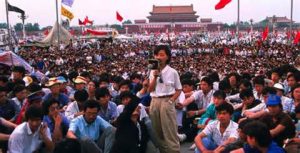 |
| Chai Ling in Tiananmen Speaking to Students 1989 |
“There will be a price to pay for all of this,” the 23-year-old child psychology graduate warned, tears streaming down her cheeks. “Some people will have to die for democracy, but it will be worth it.”
Chai, the object of a year-long nationwide search by the Chinese government after the violence in the square, would eventually escape China to Hong Kong, sealed for five days and nights in a wooden crate deep in the hold of a rickety ship. She managed to elude capture in China by adopting a series of disguises, learning local Chinese dialects, and working variously as a rice farmer, laborer, and maid. Eventually, she would come to the United States, be nominated for the Nobel Peace Prize, and graduate from Harvard Business School.
Barely eight hours after my conversation with Chai, her warning would become a reality. Late in the evening of June 3 and during the early morning hours of June 4, the lethargy of weary demonstrators and the cacophony of boom box music would be replaced by shrieks of terror, gunfire, and the guttural roar of tank and armored personnel carrier engines as the People’s Liberation Army rolled into the square, crushing tents and firing indiscriminately at protesters and anybody else who got in their way.
A couple of hours before the violence erupted, a few foreign correspondents had enjoyed a quiet meal together in the venerable Beijing Hotel on Chang’an Avenue, a few blocks from the square.
While dining, we discussed the events of the night before when several thousand young unarmed military recruits were sent marching toward the students in Tiananmen Square. Before they got very far, an estimated 100,000 Chinese civilians poured from their homes near the square. They confronted the soldiers—berating them for even thinking of entering Tiananmen to clear it of the thousands of students who had occupied it since late April.
This rather benign event was nothing more than a probe to determine what kind of resistance armed troops might face when they stormed the square. 200,000 Chinese troops—most from provinces far from Beijing—had been massing on the city’s outskirts for several weeks.
As Beijing entered its 15th day of martial law, it was obvious that the government could still not enforce that decree. The government admonished foreign media members to “observe regulations on news coverage” related to martial law.
“Foreign journalists must not talk with student protesters, and any news coverage of any kind in Beijing must receive prior approval,” said Ding Weijun, the city’s spokesman.
The statement also warned the hundreds of foreign reporters still in Beijing against inviting Chinese citizens to their offices, homes, or hotels to conduct “interviews regarding prohibited activities.” Several foreign reporters had been expelled from the country for violating those rules.
Many of us ignored those edicts and talked to anybody who wanted to speak anywhere deemed away from government authorities’ prying eyes and ears. I also ignored the curfew, often riding my red and white Sprick bicycle down dark streets from my hotel to the Tribune’s offices in a foreign housing compound a half-mile away. I got to know most Chinese police who were supposed to enforce the curfew. They would smile and wave as I peddled past.
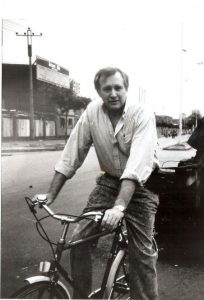 |
| Aboard my Sprick Bicycle |
The morning of June 3, once again ignoring marital law rules, I took the Tribune car and my nervous Chinese driver. We drove outside of the square and into several neighborhoods where streets leading toward Tiananmen had been shut down by angry civilians intent on keeping the Chinese Army from reaching the students. Dozens of intersections were blocked with buses, trucks, and makeshift barricades. Neighborhood leaders proudly showed me their arsenal of weapons—rows of gasoline-filled bottles complete with cloth wicks, piles of rocks and bricks, shovels, rakes, picks, and other garden tools.
“We will protect the students,” a man named Liang Hong told me.
“But how?” I asked. “The army has tanks, machine guns, and armored personnel carriers. They will kill you.”
“Then we will die,” he replied. Several dozen others quickly echoed his words. “Yes, we will all die. These are our children in the square. We must help them even if it means death.”
Several days after the attack on the square, when the authorities allowed people to travel once again in the city, I drove back to this same neighborhood. True to their word, I was told that Liang Hong and several of his neighbors had died or were wounded attempting to keep the army from entering the square.
After dinner in the Beijing Hotel, I decided to take one more stroll through the square. As I rode into the square on the bicycle I had purchased after my arrival in Beijing from Tokyo two weeks before, I could see that many of the students were spooked—not only by the unarmed incursion of the night before but by the intelligence pouring in from the neighborhoods surrounding the square that the army was on the move.
“I think something will happen tonight,” one told me. “I am very afraid.”
I stopped at the foot of the Goddess of Democracy. Several small spotlights illuminated the statue as it looked toward the Forbidden City and Mao’s portrait. On the square’s edge, I bought a bottle of Coca-Cola and then pushed my bicycle toward the four-story KFC restaurant on the square’s south end. It was about 8:30 p.m. The restaurant (the largest KFC store in the world) was almost empty.
I then rode the 2 miles down Jianguomenwei Avenue to the Jianguo Hotel, where I was staying. I needed to file a story on the day’s events—specifically my conversation with Chai Ling and the other students that afternoon. Despite the curfew, I finished writing my story around 10 p.m. and decided to ride my bicycle back to the square for one more look. I parked my bike on Xuanwumen Dong Avenue near the massive Museum of History and Revolution on the square’s east side. I walked toward the “Heroes of the Nation” obelisk, which became the students’ headquarters.
I hadn’t gotten very far when the sound of gunfire erupted. The firing seemed everywhere, amplified by the massive buildings surrounding the square. I ran toward my bicycle, not wanting to be trapped in the square should tanks roll in. Moments later, I ran into BBC correspondent Kate Adie, walking toward the square with her camera crew.
“What’s going on,” she asked.
“Looks like the army is making a move tonight,” I answered. I explained that I hadn’t seen any troops or tanks in the square at that point, but I did see muzzle flashes from the roof of the Great Hall of the People on the west side of the square. Several hundred troops had massed behind the Great Hall a day before, and I assumed they had been positioned on the roof.
I rode my bicycle north toward Chang’an Avenue. I hadn’t gotten very far when I noticed a line of Armored Personnel Carriers moving toward the square flanked by hundreds of soldiers with fixed bayonets. Seconds later, the dark sky was interlaced with red and yellow tracer fire, and I could hear bullets ricocheting off of concrete. I turned my bike around and raced toward the square’s south end. Like many of my fellow correspondents, I never thought the government would use deadly force against the students.
As the firing intensified, thousands of more residents poured out of their houses and formed human blockades where streets entered the square. They quickly became targets for the machine gun and small arms fire. As the casualties mounted, the crowds became increasingly belligerent. They armed themselves with bricks, bottles, iron rods, and wooden clubs and attacked some military contingents, including tanks.
An infuriated mob grabbed one soldier and set him afire after dousing him with gasoline. They then hung his still-smoldering body from a pedestrian overpass. It was one of the many examples of instant justice that night. The crowd accused the soldier of having shot an older woman to death.
I watched the wounded and the dead being carted from the square and the area surrounding it on the flatbeds of three-wheeled vehicles. The stinging stench of tear gas hovered over the embattled city and burned my eyes.
 |
| Carting the Wounded out of the Square |
“Tell the world!” the crowds screamed at other foreign journalists they saw and me. “Tell the United States! Tell the truth! We are students! We are common people unarmed, and they are killing us!”
Around 2 a.m., at the height of the armed assault, a maverick tank careened down Jianguomenwai Avenue in an attempt to crack open the way for troop convoys unable to pass through the milling crowds.
The tank was bombarded with stones and bottles, with its turret closed as it sped down the avenue. Young cyclists headed it off, then slowed to bring it to a halt. But the tank raced on, the cyclists deftly avoiding its clattering treads by mere inches.
On the Jianguomenwai bridge over the city’s main ring road, where a 25-truck convoy had been marooned for hours by a mass of angry civilians clambering all over it, a tank raced through the crowd. It sideswiped one of the army trucks, and a young soldier who was clinging to its side was flung off and killed instantly.
The worst fighting of the night occurred around the Minzu Hotel, west of the square, where grim-faced troops opened fire with tracer rounds on milling crowds blocking their access to the square. Bullets ripped into the crowd, and scores of people were wounded. The dead and wounded were thrown on the side of the road among a pile of abandoned bicycles as the troops moved on to take the square.
 |
| Dead and Wounded Amid Abandoned Bicycles |
One tank ran into the back of another that had stalled on Chang’an Avenue. As they hurriedly bounced apart, the machine guns on their turrets began to train on an approaching crowd of about 10,000. The machine guns erupted, sending tracers above the heads of the crowd. Men and women scurried for cover, many crawling into the piles of dead and wounded along the side of the road.
In my haste to return to the square, I had forgotten to bring my camera. Even though it was night, the square was illuminated by street lamps, and the sky above it was lit almost continuously with tracers and bright flares. I decided not to ride my bicycle to avoid becoming a larger target. At the same time, I didn’t want to lose the only form of transportation I had, so I pushed it wherever I went, sometimes crouching behind it. Finally, I found a small tree and padlocked it to the trunk.
For most of the night, I was caught between trying to cover the tragedy unfolding in and around the square and watching my back. I didn’t want to be caught in the sites of some trigger-happy soldier.
At one point, several hundred troops successfully occupied a corner of the square, and I watched as a crowd of some 3,000 howling unarmed students surged toward them on foot and by bicycle, intent on breaking through their line with their bare hands. A few in front of the main body rammed their bikes into the troops and were quickly beaten to the ground by soldiers using the butts of their rifles or clubs.
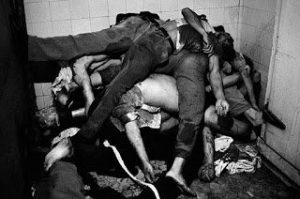 |
| Dead Demonstrators Piled in a Hospital Hallway |
“Fascists! Murderers!” the crowd chanted.
As the main body of the crowd got within 50 yards of the first line of troops, an army commander blew a whistle, and the soldiers turned and fired volleys of automatic rifle fire. Screams of pain followed.
The protesters threw themselves and their bikes on the pavement of the Avenue of Eternal Peace. Dragging their bikes behind them, they crawled to safety, pursued by rifle fire and the throaty war cries of the soldiers.
When the firing momentarily stopped, the crowd regrouped and slowly crept back toward the square. Then the volleys rang out again, more intense this time. Two lines of soldiers began to chase the mob, alternately firing tear gas and bullets. I watched several people stagger and fall to the ground.
The acrid smell of tear gas triggered a paroxysm of coughing in the crowd. People ripped off shirt sleeves and used them as handkerchiefs over their mouths. The bodies of three women were laid out on the pavement of a side street to await transport. A crowd gathered around them, waving fists and cursing the government.
“How many people did you kill?” they shouted at steel-helmeted soldiers who stood stonily with AK-47 rifles cradled across their chests.
The fighting continued throughout the night as exhausted students and other dissidents engaged in hit-and-run battles with soldiers, tanks, and APCs. Some students, many of them wounded, scrambled aboard abandoned buses seeking refuge and aid. I watched soldiers pull them out and beat them with heavy clubs.
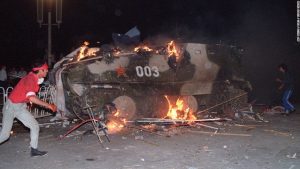 |
| Students Confront APCs in the Square |
Several of the students, bleeding from head wounds, ran toward where I had taken cover behind a low stone wall. One of the students, a girl of maybe 16, had been shot through the shoulder and was bleeding profusely. She was falling in and out of consciousness and looked to be in shock. I looked behind me to see if there was some way to get her assistance.
In the distance, I saw a man waving at me from a doorway of a brick wall. He was motioning me to bring the girl and other wounded students to him, all the while carefully watching for soldiers. With the help of another reporter, I pulled her up and dashed with her and several other wounded students to the gate. The man quickly wrapped a blanket around the girl and took her inside the compound with the other students.
“Thank you,” he said. “I am a doctor. I will take care of them.”
I jogged back to the low wall where I had been kneeling before. I recall thinking that if I were wounded, at least I now knew where I could go for help. For the next few hours, I moved from one location to another, trying to find a spot to see what was happening while ensuring I had an escape route should I come under fire.
The square was finally cleared at dawn when four personnel carriers raced across it, flattening not only the demonstrators’ tents but also the “Goddess of Liberty” statue. I looked at my watch. It was about 5:30, and dawn was breaking over the city.
Ten minutes later, a negotiated settlement allowed the hard-core remnants of the democracy movement—some 5,000 students and their supporters—to leave by the southeastern corner of the square. As they left singing the Internationale, troops ritually beat them with wooden clubs and metal rods.
The army had been ordered to clear the Square by 6 a.m., and it had done so but at a terrible cost.
As daylight broke over the Avenue of Eternal Peace, dazed knots of Chinese, many of them weeping and all of them angry at their government, stood at intersections, reliving the events of a few hours before when tracer bullets and flares turned the black Beijing sky into a deadly torrent of crimson.
Along the roadside leading into the square lay several wounded students, some perhaps already dead.
“They murdered the people. . . . They just shot the people down like dogs, with no warning,” said a man whose shirt was soaked with blood. “I carried a woman to an ambulance, but I think she was dead.”
“Please,” he said, “you must tell the world what has happened here. We need your protection from our government.”
Perhaps the defining moment of the massacre came a bit later that morning when a student jumped in front of a column of tanks on Chang’an Avenue and refused to move. As yet still unidentified, this student shouted at the tank commander: “Get out of my city. … You’re not wanted here.” Each time the tank would attempt to maneuver around the student, he would jump in front of it. The column of tanks turned off their motors, and several other students ran out and pulled the student to safety. To this day, nobody knows who the student was or what happened to him. Most Chinese still refer to him as the “tank man.”
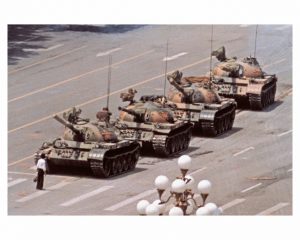 |
| The Still Unidentified “Tank Man” Confronting Tanks |
I returned to where I had left my bicycle and rode to the Jianguo Hotel. As I peddled along mostly deserted streets, I tried to understand what I had seen. With the students already dispersing from the square or planning to, the attack by the army was unnecessarily brutal.
There was little doubt that what I had witnessed was an assault designed to punish the demonstrators for embarrassing China’s leadership—Premier Li Peng and Deng Xiaoping, the ailing leader of China’s Communist Party.
China’s hard-line rulers, clearly in control after the bloodbath, issued a statement that morning that said:
“Thugs frenziedly attacked People’s Liberation Army troops, seizing weapons, erecting barricades and beating soldiers and officers in an attempt to overthrow the government of the People’s Republic of China and socialism.”
China’s leaders have not forgotten the pro-democracy demonstrations of 1989. Unnerved by turbulence among Tibetans and always nervous about the possibility of human rights protests in the heart of the capital, China barred live television coverage from Tiananmen Square during the 2008 Beijing Olympics—just as it had in 1989. It will probably do the same on the 35th anniversary of the slaughter.
However, it remains to be seen whether or not such a ban will exorcise the ghosts of June 4, 1989, that still hang over Tiananmen Square. There is little doubt that time has not healed the deep wounds inflicted on China’s people on that terrible night 35 years ago.
CLICK BELOW FOR MY SHORT INTERVIEW WITH NATIONAL PUBLIC RADIO ON THE 25TH ANNIVERSARY OF THE MASSACRE.
If you enjoyed this post, please consider subscribing to ForeignCorrespondent and tell your friends to subscribe. IT’S FREE! WHAT A DEAL! If you’ve received this from a friend and would like to be added to our distribution list for future blog posts, please enter your email address in the sign-up in the notifications box at:
https://ronaldyatesbooks.com/category/foreign-correspondent.
You can also find my commentaries on Substack at https://ronyates.substack.com/ and the American Free News Network at https://afnn.us.
Please feel free to comment. WE LOVE COMMENTS!










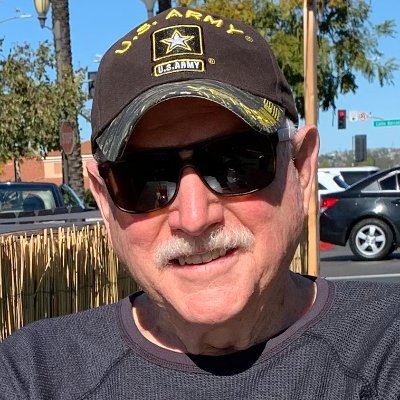
Thanks for your eye witness account of these brutal days. I had never read anything as descriptive.
Biden is owned by several foreign governments – literally – and clearly envies the Chinese control of dissenters. The Demoncrats are doing everything they can to implement totalitarian control of our Nation and, sadly, I have this far seen nothing from the so-called Republicans to challenge those moves
You are correct on all counts, Joe. By locking up and violating the civil rights of dozens of Americans who protested the 2020 election results on Jan. 6, 2020, the Dems and Biden are employing the CCP’s playbook on how to deal with dissenters. Biden is the closest thing to a tyrant that I have seen in my lifetime.
I wish to second Joe’s praise of this reportage—the best description of the scene I’ve ever encountered. And such a great turn of phrase to set the scene prior to the military action and emphasize the contrast—”Disneyland of Dissent.”
Thanks, J.C. Some stories simply remain vivid in the memory banks. Tiananmen Square is one of those for me.